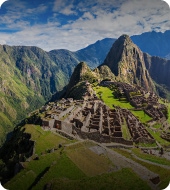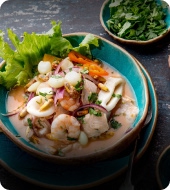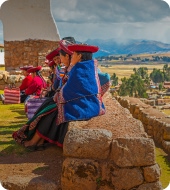
Traveling to Peru without speaking Spanish
Written by:Valencia Travel
Last Update: 2025-02-18
Peru is a country located in the central part of South America, bordered by Ecuador, Colombia, Brazil, Chile, and Bolivia. The country is home to 38 million people, making it one of the largest countries in South America. The official language of Peru is Spanish so most people speak Spanish, along with a number of other indigenous languages, with over 84% of the population speaking it as their first language. However, English is also spoken in Peru, with about 11% of the population speaking it as their second language. When you are booking a trip to Peru you are probably wondering if it is necessary to be fluent in Spanish or if can you get by with English on your visit to the country. Here is some use useful information.
Machu Picchu
What Language Do They Speak in Peru?
The main language and the official language of Peru is Spanish. Spanish is spoken by approximately 84% of the population. However, Peru is a multilingual country with over 72 Indigenous languages and dialects spoken by people from the different regions of the country. In the cities, especially the coastal region, most people are monolingual and only speak Spanish. Many locals in tourist areas speak at least basic English. English is generally taught in schools and is included in the curriculum. Spanish was introduced to Peru by Spanish colonists in 1532 and became the most used language of communication for travelers in the country. After Peru gained its independence in 1821, Spanish remained the official language. When it comes to Indigenous languages Quechua is the second most commonly spoken language, spoken by around 13% of the population, especially in The Andes. Aymara is spoken by around 2% of the population. The other Indigenous languages are spoken primarily in the central Andes, the Amazon rainforest, and the south of Peru, near the Bolivian border. Asháninka and Aguaruna are the most common indigenous languages spoken in the Amazon region.
Spanish Book
Traveling to Peru
If you plan to visit Peru with little to no Spanish-speaking skills, we would recommend spending a lot of your time in Lima and Cusco. Once you get outside those areas, things will become a lot more difficult without Spanish. You can spend most of your time in the tourist districts of Lima, like Miraflores and Barranco, where you can interact with many people who can speak some English – no matter what you’re doing. Miraflores is an upper-class neighborhood in Lima filled with tourists. Speaking some English is pretty important for a number of Peruvians working and living in the area. In Cusco, the city thrives on tourism. The locals have a huge incentive to learn some English. If they can communicate in English, they’ll get a better jobs in the tourism industry. So you don’t need to avoid going to Peru just because you don’t speak Spanish. You can travel to Peru without knowing any Spanish at all and still have a fantastic trip. As a tourist, you’re more likely to meet English-speaking Peruvians, especially if you’re traveling along the popular touristic routes. Tour operators, guides, hotel and hostel staff, and other people working in the tourism industry in cities like Cusco, Puno, and Arequipa are far more likely to have some basic level of conversational English, with many speaking excellent English.
Travel to Peru
It’s easier with a tour package as you’ll have a guide for most of the time, but you can also travel completely independently, including as a backpacker, with no Spanish. You’ll struggle at times, but keep a smile on your face and you’ll do just fine. It is worth downloading a language app for your smartphone (if you travel with one). At least then you can type out the English, receive a translation, and then try to speak it out loud or just show the translation on the screen. You will find that most people in the tourist areas speak English, and you will be able to get by in most restaurants and shops. However, you may have difficulty communicating with locals in more remote areas. After a few days of attempting to complete even the simplest of tasks, travelers may experience mental exhaustion. If you put in some effort before your trip, to learn just a few phrases, or learn to speak Spanish, you will reap the rewards as soon as you arrive on Peruvian soil.
Learn Spanish
The Benefits of Speaking Spanish in Peru
If you need some motivation to learn to speak Spanish for your Peru trip, here are just a few reasons to start studying before you travel.
You’ll find it far easier to travel around Peru if you can ask for basic information like arrival times and travel durations. Also, being able to ask a bus driver or passenger where exactly you are and when you should get off is a huge bonus.
You’ll be able to save money every day by negotiating fares, haggling for prices, and spotting rip-offs, among other things.
You’ll be able to communicate with the locals. Even if it’s only a very basic conversation, it will go a long way to forming bonds and positive memories with the local people. And that’s a pretty fundamental part of traveling.
You’ll be more comfortable traveling off the tourist trail in places where English speakers are rare.
You won’t feel so lost when it’s time to order in restaurants, cafes, and bars.
You’ll have fun when you speak Spanish in Peru. Well, not always: sometimes trying to speak Spanish is a migraine-inducing nightmare, especially if you’re just starting to learn and you’re on a long trip. But it can be fun.
Guinea Pig
If you want to get the most out of your Peru trip and travel in a far more relaxed manner, then having the ability to speak Spanish in Peru goes a long, long way. Even if you just learn some basics, you’ll have a far easier time getting around, ordering in restaurants, and dealing with simple day-to-day interactions so you can concentrate on making the most of your vacation in Peru!
 Aventure
Aventure
 Cultural
Cultural
 Gastronomy
Gastronomy
 Wellness
Wellness
 Local Living
Local Living
 Luxury
Luxury












